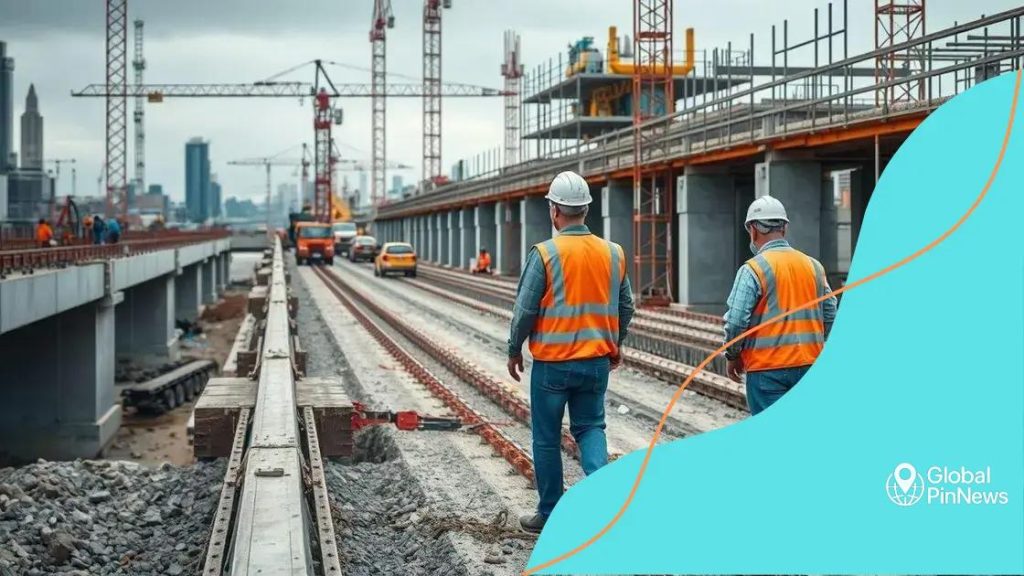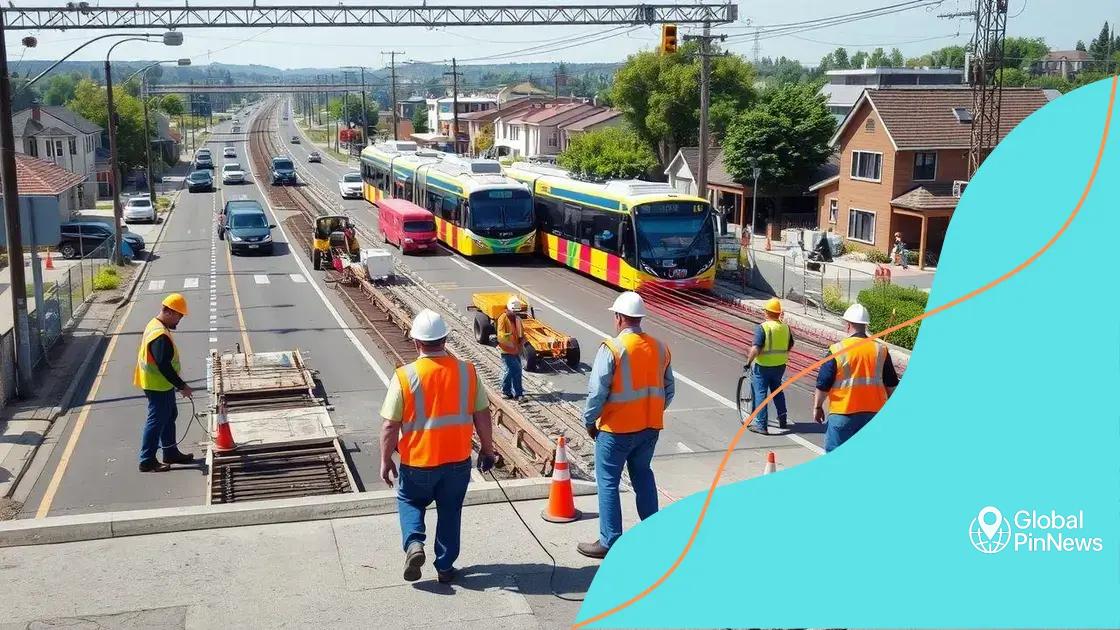Infrastructure bill implementation status: what to expect

The infrastructure bill focuses on improving transportation, expanding broadband access, enhancing water systems, and creating jobs, while addressing implementation challenges such as funding delays and regulatory issues.
Infrastructure bill implementation status is a hot topic as communities eagerly await improvements. How will this affect local development projects? Let’s dive in.
Overview of the infrastructure bill
The infrastructure bill is a significant piece of legislation aimed at revitalizing America’s aging infrastructure. It focuses on projects that enhance transportation, broadband access, and energy systems. Understanding the details of this bill can provide insights into its effects on local communities.
Key Components
There are several key components within the bill that aim to improve various sectors.
- Investment in public transit systems to make them more efficient.
- Funding for high-speed internet to connect underserved areas.
- Upgrade of roads and bridges to ensure safety and longevity.
- Improvements to water supply and sewer systems to enhance public health.
The overall funding allocated for these improvements is substantial, primarily targeting areas that need it most. Each allocation aims to support local governments in implementing necessary changes.
Impact on Local Communities
Communities across the nation will feel the impact of the infrastructure bill. As projects get underway, jobs will be created, which is crucial for local economies. The improvements will not only enhance functionality but also attract businesses seeking reliable infrastructure.
Moreover, the bill emphasizes sustainability. This shift towards eco-friendly solutions will help pave the way for a greener future while maintaining job creation. As cities adapt to these changes, the quality of life for many residents will improve significantly.
With a variety of sectors benefiting, the long-term effects are expected to be positive, ultimately supporting a robust economic environment across the nation. The journey ahead is promising, with many steps outlined for effective implementation.
Key provisions of the bill
The key provisions of the bill lay the groundwork for significant improvements in various infrastructure sectors. Understanding these provisions is essential for grasping how they will impact communities nationwide.
Funding Allocations
One vital aspect of the bill is the funding allocations. The bill commits a substantial amount of resources to critical areas, ensuring that renovations and new projects can move forward. Key allocations include:
- Transportation: Enhanced funding for roads, bridges, and public transit.
- Broadband: Expansion of high-speed internet access to rural and underserved areas.
- Water Infrastructure: Investments in clean drinking water and modern sewage systems.
- Energy Efficiency: Support for sustainable and renewable energy projects.
These allocations demonstrate a commitment to improving the country’s infrastructure on multiple fronts, making a direct impact on citizens’ daily lives.
Job Creation and Economic Growth
Another vital provision focuses on job creation. As infrastructure projects get underway, thousands of jobs will be available in construction, engineering, and project management. This boosts the economy significantly, especially in areas hit hardest by unemployment.
By investing in training programs, the bill also aims to equip workers with the necessary skills to meet the demands of new job opportunities. This approach fosters local economic growth and ensures that workforce readiness is high.
Additionally, these projects will spur long-term economic growth by improving business access and transportation efficiency. With these enhancements, local businesses can thrive, ultimately benefiting everyone in the community.
Environmental Considerations
The bill doesn’t only focus on infrastructure development; it also incorporates modern environmental standards. Projects funded under this legislation are required to adhere to strict guidelines that promote sustainability. This means using eco-friendly materials and methods wherever possible.
Incorporating environmentally sustainable practices ensures that the developments benefit not only the current generation but also future ones. A cleaner, greener infrastructure contributes to an improved quality of life and helps combat climate change.
Current status of implementation efforts

The current status of implementation efforts for the infrastructure bill reveals significant progress, yet challenges remain. Many projects are underway, focusing on critical improvements that will benefit communities across the nation.
Ongoing Projects
As of now, numerous infrastructure projects have started across various states. Local governments are working diligently to initiate these improvements. Some notable examples include:
- Road Repairs: Many states report significant progress in repairing and upgrading highways and local roads.
- Public Transit Enhancements: Cities are expanding and improving public transportation systems to increase accessibility.
- Broadband Expansion: Efforts to provide high-speed internet to underserved communities are gaining momentum.
- Water Infrastructure Upgrades: Projects focused on modernizing water systems are also in progress, addressing urgent health concerns.
These projects are essential for ensuring that the funds allocated by the bill are effectively utilized, creating lasting improvements in infrastructure.
Challenges Faced
While progress is evident, there are challenges to successful implementation. Some local governments face hurdles such as funding delays and regulatory red tape. Additionally, supply chain issues have made obtaining materials more difficult.
Another significant concern is community engagement. Ensuring that local voices are heard and considered in planning stages is essential for the success of projects. These challenges require ongoing dialogue between policymakers, contractors, and community members to find effective solutions.
Efforts are also being made to streamline processes to speed up project timelines. Federal support aims to alleviate some of these challenges, simplifying bureaucracy to allow for smoother implementation.
Monitoring Progress
To keep track of the various projects started under the infrastructure bill, federal and state agencies are collaborating. Regular updates and reports are necessary to inform the public about progress and address any arising issues quickly.
As these efforts continue, the commitment to transparency helps ensure that funds are used responsibly and effectively, enhancing trust in the ongoing initiatives.
Challenges faced during implementation
The challenges faced during implementation of the infrastructure bill are diverse and significant. As local governments and agencies begin to put plans into action, several obstacles have emerged, impacting the speed and effectiveness of these initiatives.
Funding Delays
One major challenge involves funding delays. Although the bill allocates substantial resources, accessing these funds can be complicated by bureaucratic processes. These delays can slow down crucial projects.
Additionally, unexpected costs often arise, leading to budgetary concerns. Local governments need to manage these funds carefully to ensure projects remain on track.
Regulatory Hurdles
Another obstacle is the regulatory framework. Implementation requires navigating various state and federal regulations, which can complicate timelines. Each project often must comply with numerous environmental and safety regulations before moving forward.
This regulatory environment can lead to prolonged planning stages. Community feedback and environmental assessments take time, which can delay construction.
Supply Chain Issues
Supply chain issues further complicate the situation. The demand for construction materials and labor has surged, leading to shortages and higher prices. These conditions hinder timely project completion and can escalate overall costs.
Additionally, disruptions caused by events such as natural disasters or pandemics can impact the availability of necessary resources, further slowing down progress.
Community Engagement
Engaging the community poses its own set of challenges. Projects often require input from residents, yet ensuring meaningful public participation can be difficult. Some communities may feel left out of the decision-making process.
Building trust and transparency is essential for successful implementation. Strategies must be developed to encourage community involvement, which can ultimately lead to stronger support for infrastructure changes.
These challenges highlight the complex landscape facing implementation efforts under the infrastructure bill. Addressing these obstacles is crucial for ensuring that the bill’s goals are met effectively and that communities benefit fully from the intended improvements.
Future outlook for infrastructure projects
The future outlook for infrastructure projects looks promising as funding, innovation, and community involvement come together. As projects funded by the infrastructure bill proceed, they are expected to reshape regions and provide numerous benefits over time.
Ongoing Investment
Investment in key areas is vital for future development. With substantial funding allocated for various infrastructure projects, local governments are prepared to undertake improvements in transportation, utilities, and public services.
- Transportation Networks: Expect enhanced roads and bridges that can handle increased traffic and provide safer travel.
- Green Energy Solutions: A focus on sustainable energy will lead to the installation of solar panels and wind turbines.
- Technology Integration: Smart infrastructure will utilize technology for better efficiency, such as smart traffic lights and connected vehicles.
These investments aim to create a robust infrastructure system that supports both the economy and community needs.
Job Creation
As projects unfold, job creation will be a significant focus. Infrastructure initiatives often lead to the development of thousands of new jobs in construction, engineering, and related fields. Local economies can benefit from these job opportunities, leading to elevated incomes and improved community standards.
Additionally, training programs designed to equip workers with necessary skills will be essential. This workforce development ensures that local residents can take advantage of the job openings created by these infrastructure projects.
Emphasis on Sustainability
Future projects will likely emphasize sustainability. With an increasing focus on protecting the environment, new regulations will guide construction practices towards eco-friendly methods. This shift aims to reduce carbon footprints and promote renewable energy usage across various projects.
Communities can anticipate initiatives that prioritize environmental health while improving infrastructure. By implementing greener practices, we can expect a shift towards sustainable living for future generations.
Overall, the outlook remains positive as ongoing efforts to tackle challenges bring about transformative changes in infrastructure. The commitment from various stakeholders will be crucial in ensuring that these projects succeed in enhancing the quality of life for all community members.
The future of infrastructure projects looks bright as significant investments, innovative approaches, and community involvement create a pathway for meaningful changes. With ongoing support, we can expect improved roads, sustainable energy solutions, and enhanced public services. This holistic approach not only addresses immediate needs but also sets the stage for future generations. Engaging communities ensures that every voice is heard, making these projects beneficial for all. Together, we can build a stronger, greener, and more connected future.
FAQ – Questions about the Infrastructure Bill and Projects
What are the main goals of the infrastructure bill?
The main goals include improving transportation systems, expanding broadband access, enhancing water infrastructure, and promoting sustainable energy solutions.
How will infrastructure projects create jobs?
Infrastructure projects will lead to the creation of thousands of jobs in construction, engineering, and technical fields as new projects are initiated.
What challenges are faced during the implementation of infrastructure projects?
Challenges include funding delays, regulatory hurdles, supply chain issues, and the need for community engagement in project planning.
How can communities get involved in infrastructure planning?
Communities can participate through public meetings, feedback sessions, and by voicing their needs and concerns to local government officials.
